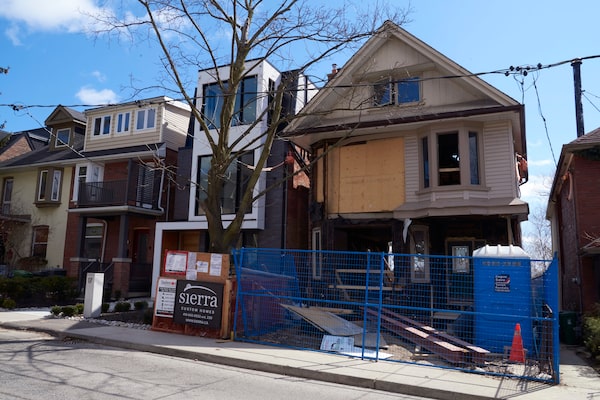
If the trend for the start of the year keeps up, we’ll see a record amount of money spent on renos in 2021.Rachel Verbin/The Canadian Press
Check your home insurance policy renewals for fallout from the wave of spending on home renovations.
If the trend for the first three months of the year keeps up, we’ll see a record amount of money spent on renos in 2021. Add the reno spending from last year and you arrive at a big reason why the cost of building materials such as lumber has spiked higher. Higher material costs put upward pressure on the cost of home insurance.
Wait, there’s more on how renos can affect your home insurance. Provided you add to the value of your house, you should absolutely let your insurance company or broker know about your project. Higher premiums could result, but do it anyway.
All that talk we hear lately about whether inflation is becoming a problem? In home insurance, climate change has been a factor in driving premium increases well beyond the reported inflation rate. Now, we have lumber price increases bouncing off last year’s inflated levels to new heights in 2021, and other material costs rising as well. These costs are of interest to your insurer because they factor into the cost of rebuilding homes and repairing damage.
“Material costs and labour costs are always a consideration taken in by insurance companies whenever they are pricing an insurance policy,” said Pete Karageorgos of the Insurance Bureau of Canada.
To avoid a post-pandemic spending spree, don’t make money decisions in a ‘hot’ state of mind
At the financial product comparison shopping website RATESDOTCA, managing editor Jameson Berkow reports that home insurance premiums related to higher material costs haven’t been noticed so far.
That could change any time because there’s no let-up in sight for reno spending. BMO Economics recently said outlays in the first three months of the year suggest a record annual reno spending of $76-billion in 2021, up from the usual $60-billion or so in prepandemic years. You can’t talk to a contractor without hearing about how scarce and expensive materials are. (Note: Lumber prices have recently eased a bit.)
Insurers are interested in the replacement cost of your home, not the market value. Most home insurance policies today include a feature that guarantees your house would be rebuilt, even if the actual cost of replacement is higher than the limit on your policy. If you’re not sure you have this, check your policy.
Something else that interests insurers: improvements or additions to your home. Add a monitored security system and you might actually save some money. Add a swimming pool, hot tub or fireplace and you take on liability risk that can increase your premiums by 10 per cent, according to Anne Marie Thomas of InsuranceHotline.com. She said other renos, even substantial ones costing more than $10,000, might only increase premiums by a very modest 1 per cent to 2 per cent.
What if you don’t let your insurer know about a change that increases the value of your home? The IBC’s Mr. Karageorgos said you could be out of pocket to replace upgrades your insurer knew nothing about – such as quartz countertops replacing Formica. “If you’re adding value or square footage, let your insurer know,” he said.
RATESDOTCA recently issued a report documenting how dramatically climate change has affected home insurance premiums. The average premium in Ontario and Alberta increased 63 per cent and 140 per cent, respectively, between 2011 and April, 2021.
The report says that if you paid $100 a month for your home insurance in 2011 and your premiums rose at the inflation rate, your cost would be $117 a month this year. Instead, the average Ontario homeowner who paid $100 a month in 2011 now pays about $163 monthly and the average Alberta resident pays $240.
Regardless of how higher costs for building materials play out in home insurance premiums, RATESDOTCA’s Mr. Berkow expects climate change to be a potential tipping point for homeowners already burdened with big mortgages.
“Eventually, it’s going to become a social issue,” he said. “People of a certain socioeconomic bracket are not going to be able to afford home insurance at a certain point.”
Your best recourse against premium hikes: a Google search for “home insurance quotes.” I ran a quick check on one property and got quotes ranging from $87 to $126 a month, which suggests there’s room to save.
Stay informed about your money. We have a newsletter from personal finance columnist Rob Carrick. Sign up today.
 Rob Carrick
Rob Carrick